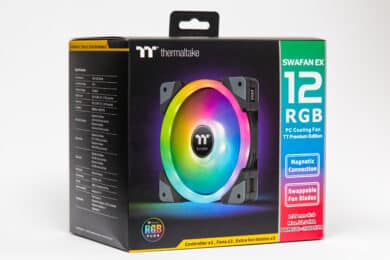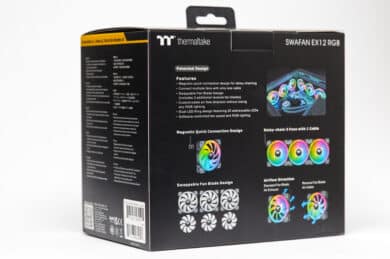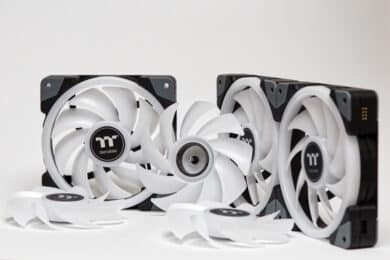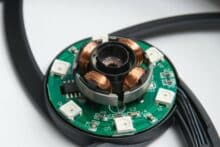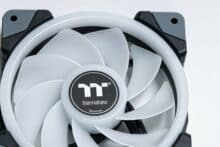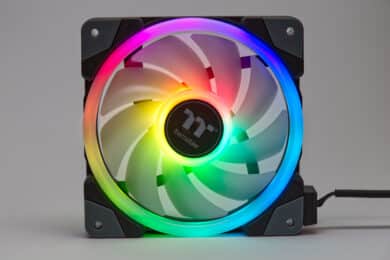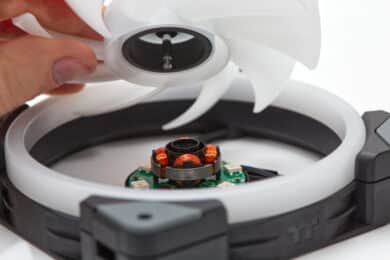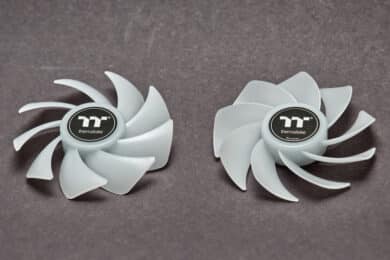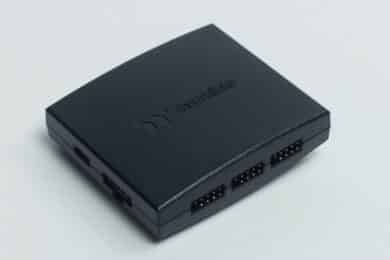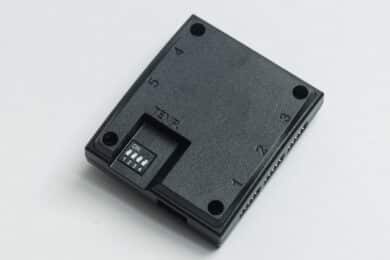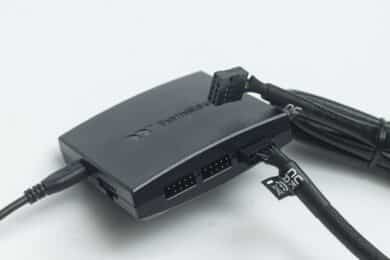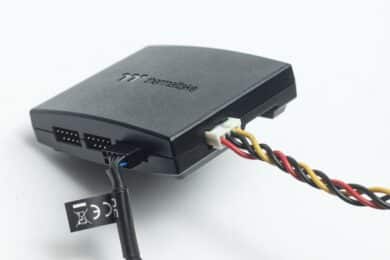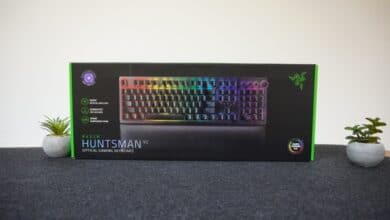
Thermaltake is active in many areas of PC components. Cases, air and water coolers, power supplies, fans and peripherals can be found in the brand’s portfolio, for example. In recent times, the focus has increasingly gone towards the upper mid-range up to premium components. Here, Thermaltake is not only inspired by the competition, but also continues to develop and combine ideas. One result of this high development is, for example, the Thermaltake SWAFAN EX12 RGB, which is subjected to a test here. Their feature list is impressive: RGB lighting, daisy-chaining (= control of multiple fans via a single cable), the namesake interchangeable fan blades, high rotation speed, software control. We take a look at how well it all works out in the Thermaltake SWAFAN EX12 RGB review.
Specifications
| Size | 120 x 120 x 25 mm |
| Connection | USB 2.0 internal |
| Software compatibility | Win 10, 11 |
| Speed | approx. 500 – 2000 RPM |
| Static pressure | 2.39 mm H2O (normal) 2.02 mm H2O (backward) |
| Airflow | 57.11 m³/h (normal) 56.26 m³/h (reverse) |
| Noise | 30.6 dB(A) (normal) 32.5 dB(A) (reverse) |
| Storage | Hydraulic |
| Price | € 108.09 * (black, set of 3) € 84.51 * (white, set of 3) |


Packaging and scope of delivery
- large packaging
- Removable fan blades, controller, long cables can be found in the package
The packaging of the Thermaltake SWAFAN EX12 RGB seems quite large for three fans at first. Ultimately, however, it becomes clear why this is so, because in addition to the three fans, the exchangeable fan blades are included, which are very comparable to the fans in terms of thickness. And on the side, you’ll find a black box with a larger amount of cables, screws, lubricant in a syringe, and the controller.
The cables are each a magnetic connection cable for the fans, unless you connect them in series. Otherwise, one of these will do. For the controller, an adapter from Molex to the necessary floppy drive power cable is included, as well as USB cables to control the controller. Fan screws are included for all three fans. Namely, one set of regular case fan screws and one set of long radiator fan screws.
Design and workmanship
- Decent build quality
- Black and white gray look
- Backward fan blades are appropriately labeled
The look of the Thermaltake SWAFAN EX12 RGB is very much on the front, where the black frame is covered by a large RGB LED ring, while the fan blades are also milky-white, intensely breaking the colors of the lighting. The four corners of the fans have medium gray rubber pads as support surfaces. Even though you can actually always orient the fans to get a good view of the illuminated front, the back is no more unsightly than other fans as well.
The build quality of the Thermaltake SWAFAN EX12 RGB turns out to be decent in this review. The case is modern in its matte black look and you don’t leave any fingerprints on it. The material looks like upper mid-range in terms of quality and is torsion-resistant. However, the RGB ring in the frame is quite wide and thus reduces the space that the fan blades would have. In addition, the fan blades are kept sturdy, which is important for stability when removing them. But they have a not quite small distance to the frame. In short, the fan blades are a bit smaller than they are on some other 120mm fans. From one end of the fan blades to the other, the Thermaltake SWAFAN EX12 RGB come in at about 10.3 inches. In comparison, the ENDORFY Fluctus 120 PWM RGB come in at about 11.1 cm.
Only Thermaltake’s logo can be seen on the regular fan blades. The “reverse” fan blades are provided with the additional lettering “reverse”.
RGB lighting
- bright illumination
- vivid colors
- good dispersion of light
The lighting of the Thermaltake SWAFAN EX12 RGB is very bright and powerful; the transitions smooth and you can not see the LEDs out individually. This gives a really very high-quality impression. The colors are very clear and the effects in the software (more on that later) are chosen quite sensibly. And according to the change concept – more about that in a moment – the fans can be used in a way that you always look at them from the front. Unless they are placed in the front of the case, and here you have to decide whether you want to optimize the view of the fans from the front or from the inside.
Change!
- With a little force, the fan blades can be pushed out
- the change is simple
- if necessary, you can use the lubricant
It’s a little scary to take fans apart. But the possibility is part of the features of this model. For the test of the Thermaltake SWAFAN EX12 RGB, this includes changing the fan blades. To do this, simply push out the factory-fitted “normal” fan blades and insert the “backwards” ones. Well – pushing out the fan blades still requires an almost frightening amount of force, so I was initially afraid of breaking something. But the fan blades are built tough enough and popped out completely unharmed.
Pushing in the other fan blades then went without a hitch. Now you can use the fans in such situations seen from the nice side, where you would see other fans from behind. For example, in pull configuration on the radiator.
The unused fan blades should be stored well protected from dust in the package. Dust in the bearing could negatively affect the performance. In the package there is also some lubricant for the bearings, if you have changed the fan blades more often. This is not yet necessary for the first few replacements; here you should take it easy on the included syringe for a while.
The ability to remove the fan blades also makes cleaning easier.
Setup and control
- Controller supplied with the unit
- Connection via internal USB 2.0 ports
- Power supply with floppy drive power connector
Unlike regular fans, the Thermaltake SWAFAN EX12 RGB are not controlled with regular fan connectors, instead they come with a controller with internal USB connectors. This proprietary control has both advantages and disadvantages. On the one hand, you are less dependent on the motherboard and its fan headers, and you have control over fan speed and RGB lighting via software. Also, there is no cable clutter since one cable is used for both fan control and RGB control. On the other hand, the controller is necessary and it’s not a simple plug-and-play solution.
The power supply of the controller is cleverly solved. This is supplied with power via the connector that was intended for floppy drives. Most power supplies still come with this connector, but since hardly anyone uses floppy drives anymore, the connector is almost always unused. If you use a power supply without this connector or want to use multiple controllers from Thermaltake, you can use the included Molex adapter.
The fans themselves do not have any permanently mounted cables. Similar to the Seasonic MagFlow 1225 PWM, the fans can be magnetically connected together and pass the signal along. One of the cables (also magnetic) must now be connected at one end and connected to the controller. This leads to a very neat cabling without cable tangle. Occasionally I had to place the connector several times, because it did not sit 100% correctly and thus had no correct connection. No problem if you know it, but I was initially confused when the freshly wired fans times did not start.
Software
- Operation is a bit awkward in parts
- Functionality is good, the fan profiles relatively quiet and lighting effects useful
The software for operating the Thermaltake SWAFAN EX12 RGB is called TT RGB Plus, which is around 150 MB at the time of testing. This is linked quite far down on the official product page of the Thermaltake SWAFAN for download.
As long as the software is not yet started, the fans run at a high speed and glow in rainbow colors. So, for optimal operation of the fans, the program should be set to open automatically at system startup.
In the software, you first have to select which type of Thermaltake component – in this case, the SWAFAN EX12 – sits at which of the controller’s five ports. Now you can make the settings. Fan speed, illumination, etc. In principle, this works quite reliably. However, the control is partly not quite as intuitive as I would like it to be.For example, the settings window of the fan speed jumps back to the overview when you click into another window. In addition, the program asks after almost every change whether you want to save it. Here I would personally like it better if it would simply either accept the changes or ask you when closing the program if you want to save.

One lighting mode that I personally like a lot, that is the temperature display. Thus, the fans remain blue in the range up to about 40°C CPU temperature, then rise over light blue, to green, yellow and orange, until finally at about 65°C red is reached. Thereby, the transitions are smooth and pleasantly designed and don’t jump harshly flashing from one color to another, as I had already experienced with other controllers, for example.
The default settings of the software are such that the fans really run quite quietly and also don’t rev up too frantically. This is quite pleasant.
Performance comparison
- Tested with regular fan blades only for comparability
- Test two similarly priced comparison fans with similar feature sets
The comparison with other fans will be done in the regular Thermaltake SWAFAN EX12 RGB feature set and not with the “backwards” fan blades. Simply because the other fans do not offer this feature and the test should take place under consistent conditions for the best comparison opportunity. Three setups are tested for the fans. Once as a case fan, once as a radiator fan and once as a fan on the air cooler. Other fans with similar features are used for the comparison. In addition, all fans in the comparison are found in a rather high price range. Once the Corsair iCue QL120 RGB, which offer similar lighting with illuminated fan blades and a powerful light ring on the frame. Then there’s the Seasonic MagFlow 1225 PWM, which are unlit but connect in a similar way.
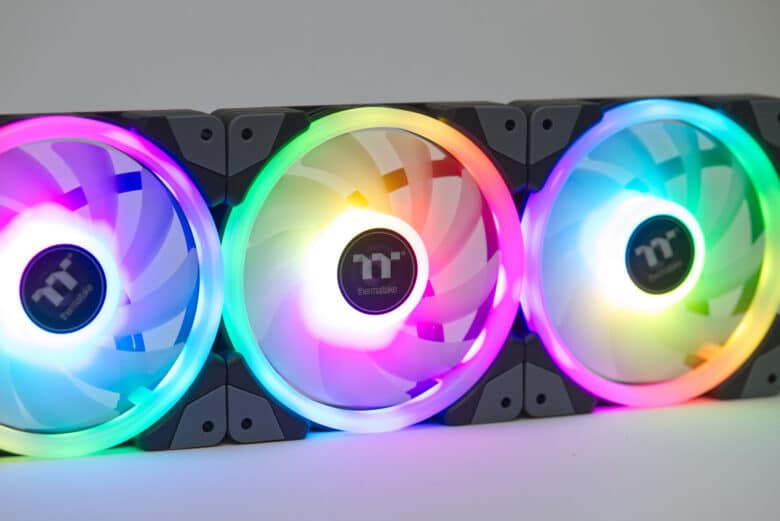
Test procedure
- Test in three scenarios (case fan / radiator fan / air cooler fan)
- Uniform procedures for good comparability are used
The fans are subjected to the test in three scenarios. Once as a case fan in the DeepCool CH510 Mesh Digital. Then as a radiator fan on an Arctic Liquid Freezer II 240 mm and finally also on a DeepCool AK400 air cooler. In all tests, the fans are tested once each at a uniform 1100 RPM (120mm fan), then at a very quiet 31 dB(A), and also at maximum power. All other fans in the system are set to uniform speeds so as not to influence the test further.
For the case fan test, one fan is placed at the bottom front of the case and one at the back. For the radiator fan test, the radiator is installed in the front of the Fractal Design Pop XL Air and the fans are accordingly also located in the front behind the fan grille. In the air cooler fan test, only one fan is used at a time.
The results are then adjusted for the room temperature and given as a delta, so that fluctuations in room temperature do not influence the comparison. The room temperature has to be added to the temperature in the table. So, if there is a temperature delta of 30 Kelvin in the table and you have a room temperature of 23°C, the measured temperature is 53°C.
Use as a case fan
At 1100 RPM
Fan at 31 dB(A)
| Image | Fan name | Temperature delta | RPM |
 |
Thermaltake SWAFAN EX12 RGB | 40 (GPU) + 29.3 (CPU) | 990 |
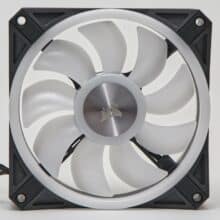 |
Corsair iCue QL120 RGB | 36.5 (GPU) + 29.5 (CPU) | 940 |
 |
Seasonic MagFlow 1225 PWM | 36.9 (GPU) + 29.1 (CPU) | 830 |
Case fan power
Case fan performance evaluation
As a case fan, the Thermaltake SWAFAN EX12 RGB can’t really convince. In this comparison, competing fans perform better, with the Seasonic MagFlow 1225 PWM pulling in the best results for performance, and the Corsair iCue QL120 RGB for volume. Performance-wise, the Thermaltake are noticeably lagging behind. The best case fans in this comparison are the Corsair QL120.
The Thermaltake SWAFAN EX12 RGB as a radiator fan
At 1100 RPM
| Image | Fan name | Temperature delta | dB(A) |
 |
Thermaltake SWAFAN EX12 RGB | 44 | 33.4 |
 |
Corsair iCue QL120 RGB | 46.5 | 34.3 |
 |
Seasonic MagFlow 1225 PWM | 41.3 | 38.2 |
Fan at 31 dB(A)
| Image | Fan name | Temperature delta | RPM |
 |
Thermaltake SWAFAN EX12 RGB | 47.8 | 930 |
 |
Corsair iCue QL120 RGB | 51.3 | 880 |
 |
Seasonic MagFlow 1225 PWM | 47.3 | 790 |
Maximum power of radiator fans
| Image | Fan name | Temperature delta | dB(A) |
 |
Thermaltake SWAFAN EX12 RGB | 36 | 51.7 @ 2270 RPM |
 |
Corsair iCue QL120 RGB | 39.8 | 44.1 @ 1620 RPM |
 |
Seasonic MagFlow 1225 PWM | 35 | 51.4 @ 2000 RPM |
Rating the radiator fan performance
On the radiator, things look different right away. Here, the Corsair fans fall off significantly. As a result, the Thermaltake SWAFAN EX12 RGB perform much better and also come very close to the Seasonic fans. This is not yet noticeable at uniform speed, but as soon as it comes to equivalent volume, the gap is no longer huge. And the SWAFAN can almost catch up to the Seasonic MagFlow’s performance even at maximum power due to the high speed, landing within the range of measurement tolerance in terms of loudness.
Testing on the air cooler
At 1100 RPM
| Image | Fan name | Temperature delta | dB(A) |
 |
Thermaltake SWAFAN EX12 RGB | 51.4 | 30 |
 |
Corsair iCue QL120 RGB | 53.7 | 30 |
 |
Seasonic MagFlow 1225 PWM | 49.9 | 30 |
Fan at 31 dB(A)
| Image | Fan name | Temperature delta | RPM |
 |
Thermaltake SWAFAN EX12 RGB | 50.4 | 1265 |
 |
Corsair iCue QL120 RGB | 53 | 1230 |
 |
Seasonic MagFlow 1225 PWM | 49.9 | 1170 |
Maximum power of air cooler fans
| Image | Fan name | Temperature delta | dB(A) |
 |
Thermaltake SWAFAN EX12 RGB | 48.1 | 41.9 @ 2030 RPM |
 |
Corsair iCue QL120 RGB | 51 | 38.2 @ 1715 RPM |
 |
Seasonic MagFlow 1225 PWM | 47.3 | 42.4 @ 1955 RPM |
Evaluation of performance on air cooler
Okay, air coolers don’t principally conform to the daisy chain concept and I suspect that won’t be the most common use for these fans. Nevertheless, the Thermaltake SWAFAN EX12 RGB do not do badly. The results are about the same as the test on the radiator. The Seasonic are ahead in terms of performance. The Thermaltake SWAFAN EX12 RGB follow at a close distance. The Corsair QL120 are clearly beaten off.
Conclusion
The Thermaltake SWAFAN EX12 RGB are decently crafted fans with some cool features and high-quality lighting. However, similar to the Corsair QL120, the initial cost is quite high. In terms of performance, the SWAFAN EX12 RGB are not overly convincing. In regular operation, they are quite quiet, but at the upper end of the performance range, they push themselves into a clearly audible range. As a fan on the radiator or the – as a place of use rather unlikely – air cooler, the Thermaltake SWAFAN EX12 RGB bring a solid average performance. As case fans, they are rather less convincing, which is in contrast to the Corsair QL120, which provide decent case fan performance, but fall short in other areas. So, in order to achieve good case fan performance with the Thermaltake SWAFAN EX12 RGB, you should aim for quite a full complement to compensate for the low individual fan performance through mass. Which brings us back to the problem with the high price.
Ultimately, two hearts beat in my chest: in terms of pure performance, I have a hard time recommending the fans at this price. But hey: If you’re considering these fans, you certainly don’t want a Noctua brown in your computer. And the build quality is good, the features clearly stand out from the crowd, and the lighting is up to par.
Thermaltake SWAFAN EX12 RGB
Workmanship
Features
Performance
Noise level
81/100
The Thermaltake SWAFAN EX12 RGB are good looking and flexible fans that remain relatively quiet, but are not overly powerful.



